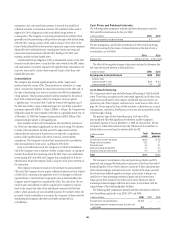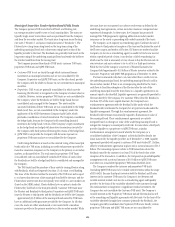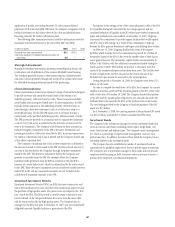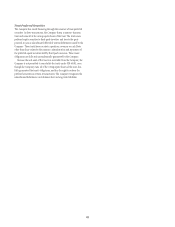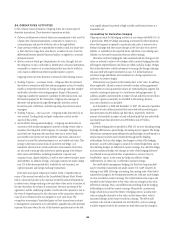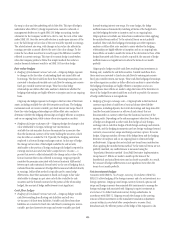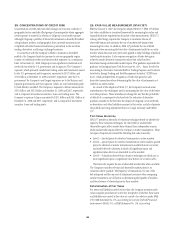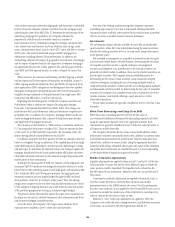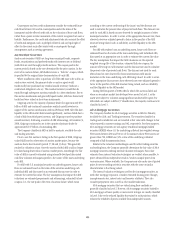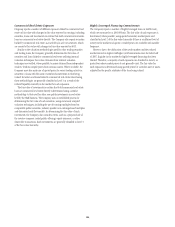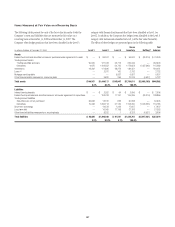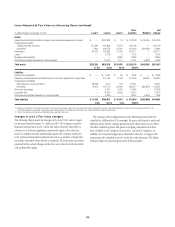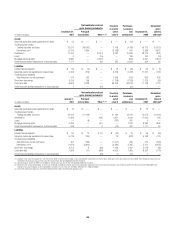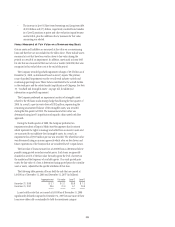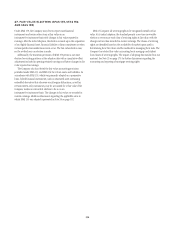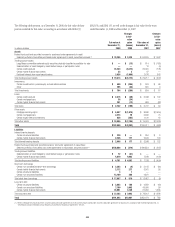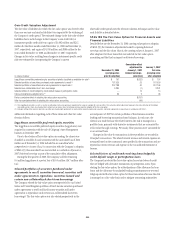Citibank 2008 Annual Report Download - page 201
Download and view the complete annual report
Please find page 201 of the 2008 Citibank annual report below. You can navigate through the pages in the report by either clicking on the pages listed below, or by using the keyword search tool below to find specific information within the annual report.Counterparty and own credit adjustments consider the estimated future
cash flows between Citi and its counterparties under the terms of the
instrument and the effect of credit risk on the valuation of those cash flows,
rather than a point-in-time assessment of the current recognized net asset or
liability. Furthermore, the credit-risk adjustments take into account the effect
of credit-risk mitigants, such as pledged collateral and any legal right of
offset (to the extent such offset exists) with a counterparty through
arrangements such as netting agreements.
Auction Rate Securities
Auction rate securities (ARS) are long-term municipal bonds, corporate
bonds, securitizations and preferred stocks with interest rates or dividend
yields that are reset through periodic auctions. The coupon paid in the
current period is based on the rate determined by the prior auction. In the
event of an auction failure, ARS holders receive a “fail rate” coupon, which
is specified by the original issue documentation of each ARS.
Where insufficient orders to purchase all of the ARS issue to be sold in an
auction were received, the primary dealer or auction agent would
traditionally have purchased any residual unsold inventory (without a
contractual obligation to do so). This residual inventory would then be
repaid through subsequent auctions, typically in a short timeframe. Due to
this auction mechanism and generally liquid market, ARS have historically
traded and were valued as short-term instruments.
Citigroup acted in the capacity of primary dealer for approximately $72
billion of ARS and continued to purchase residual unsold inventory in
support of the auction mechanism until mid-February 2008. After this date,
liquidity in the ARS market deteriorated significantly, auctions failed due to
a lack of bids from third-party investors, and Citigroup ceased to purchase
unsold inventory. Following a number of ARS refinancings, at December 31,
2008, Citigroup continued to act in the capacity of primary dealer for
approximately $37 billion of outstanding ARS.
The Company classifies its ARS as held-to-maturity, available-for-sale
and trading securities.
Prior to our first auction’s failing in the first quarter of 2008, Citigroup
valued ARS based on observation of auction market prices, because the
auctions had a short maturity period (7, 28 and 35 days). This generally
resulted in valuations at par. Once the auctions failed, ARS could no longer
be valued using observation of auction market prices. Accordingly, the fair
value of ARS is currently estimated using internally developed discounted
cash flow valuation techniques specific to the nature of the assets underlying
each ARS.
For ARS with U.S. municipal securities as underlying assets, future cash
flows are estimated based on the terms of the securities underlying each
individual ARS and discounted at an estimated discount rate in order to
estimate the current fair value. The key assumptions that impact the ARS
valuations are estimated prepayments and refinancings, estimated fail rate
coupons (i.e., the rate paid in the event of auction failure, which varies
according to the current credit rating of the issuer) and the discount rate
used to calculate the present value of projected cash flows. The discount rate
used for each ARS is based on rates observed for straight issuances of other
municipal securities. In order to arrive at the appropriate discount rate, these
observed rates were adjusted upward to factor in the specifics of the ARS
structure being valued, such as callability, and the illiquidity in the ARS
market.
For ARS with student loans as underlying assets, future cash flows are
estimated based on the terms of the loans underlying each individual ARS,
discounted at an appropriate rate in order to estimate the current fair value.
The key assumptions that impact the ARS valuations are the expected
weighted average life of the structure, estimated fail rate coupons, the
amount of leverage in each structure and the discount rate used to calculate
the present value of projected cash flows. The discount rate used for each
ARS is based on rates observed for basic securitizations with similar
maturities to the loans underlying each ARS being valued. In order to arrive
at the appropriate discount rate, these observed rates were adjusted upward to
factor in the specifics of the ARS structure being valued, such as callability,
and the illiquidity in the ARS market.
During the first quarter of 2008, ARS for which the auctions failed and
where no secondary market has developed were moved to Level 3, as the
assets were subject to valuation using significant unobservable inputs. For
ARS which are subject to SFAS 157 classification, the majority continue to be
classified in Level 3.
Alt-A Mortgage Securities
The Company classifies its Alt-A mortgage securities as Held-to-Maturity,
Available-for-Sale, and Trading investments. The securities classified as
trading and available-for-sale are recorded at fair value with changes in fair
value reported in current earnings and OCI, respectively. For these purposes,
Alt-A mortgage securities are non-agency residential mortgage-backed
securities (RMBS) where (1) the underlying collateral has weighted average
FICO scores between 680 and 720 or (2) for instances where FICO scores are
greater than 720, RMBS have 30% or less of the underlying collateral
composed of full documentation loans.
Similar to the valuation methodologies used for other trading securities
and trading loans, the Company generally determines the fair value of Alt-A
mortgage securities utilizing internal valuation techniques. Fair-value
estimates from internal valuation techniques are verified, where possible, to
prices obtained from independent vendors. Vendors compile prices from
various sources. Where available, the Company may also make use of quoted
prices for recent trading activity in securities with the same or similar
characteristics to that being valued.
The internal valuation techniques used for Alt-A mortgage securities, as
with other mortgage exposures, consider estimated housing price changes,
unemployment rates, interest rates and borrower attributes. They also
consider prepayment rates as well as other market indicators.
Alt-A mortgage securities that are valued using these methods are
generally classified as Level 2. However, Alt-A mortgage securities backed by
Alt-A mortgages of lower quality or more recent vintages are mostly classified
in Level 3 due to the reduced liquidity that exists for such positions, which
reduces the reliability of prices available from independent sources.
195


